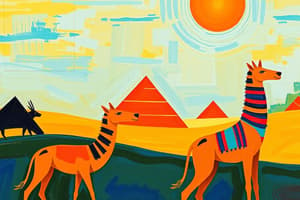Podcast
Questions and Answers
What is surface litter composed of?
What is surface litter composed of?
- Leaves, branches, and sand
- Animal scats and bodies
- Mushrooms and other rotting matter
- All of the above (correct)
What is topsoil/hummus?
What is topsoil/hummus?
Rotting organic matter from litter layer and minerals from weathering rocks
Describe subsoil.
Describe subsoil.
Crumbling rock, sand, clay, gravel & silt
What is parent material in soil?
What is parent material in soil?
Factors that affect soil formation include ______, climate, organisms, relief, humans, and time.
Factors that affect soil formation include ______, climate, organisms, relief, humans, and time.
Which are characteristics of desert soils?
Which are characteristics of desert soils?
What is entisoil?
What is entisoil?
What are the characteristics of Aridisols?
What are the characteristics of Aridisols?
What is salinization?
What is salinization?
Flashcards are hidden until you start studying
Study Notes
Soil Composition and Layers
- Surface Litter: Comprises leaves, branches, animal excreta, carcasses, mushrooms, and decomposing organic matter.
- Topsoil/Humus: Formed from the decomposition of surface litter with minerals from weathered rocks.
- Subsoil: Contains fragmented rock materials, including sand, clay, gravel, and silt.
- Parent Material: Refers to the bedrock that lies beneath the soil layers.
Factors Influencing Soil Formation
- Parent Material: Affects permeability, mineral content, soil texture, and nutrient availability.
- Climate: Influences weathering processes, precipitation levels, and temperature variations.
- Organisms: Contribute organic matter and play a critical role in nutrient cycling and recycling.
- Relief: Encompasses aspects like altitude, slope angle, and orientation which affect soil development.
- Human Activity: Includes the impacts of agriculture, urbanization, and land management practices.
- Time: It can take approximately 400 years to generate 10mm of soil, requiring 3000-12000mm for sufficient agricultural depth.
Characteristics of Desert Soils
- Dry Conditions: Minimal moisture retention leads to unique soil characteristics.
- Composition: Dominated by sand and mineral-rich content; the surface often forms a crust.
- Colorful Appearance: The lack of rainfall prevents leaching, leading to rich and varied mineral hues.
- Thin Layers: Desert soils typically have very limited thickness.
- Stoniness: Often stony if deflation processes occur, which remove finer particles.
Soil Types in Deserts
- Entisol: Young, mobile soils resembling sand dunes; lack defined horizons due to constant movement.
- Aridisol: Characterized by a light color due to accumulated silica, gypsum, and calcium carbonate deposits.
Salinisation Process
- Occurs when high temperatures cause soil moisture to evaporate, pulling salts to the surface through capillary action.
- These salts can be toxic, rendering the land unusable, whether resulting from natural conditions or irrigation practices introduced to dry regions.
Studying That Suits You
Use AI to generate personalized quizzes and flashcards to suit your learning preferences.




